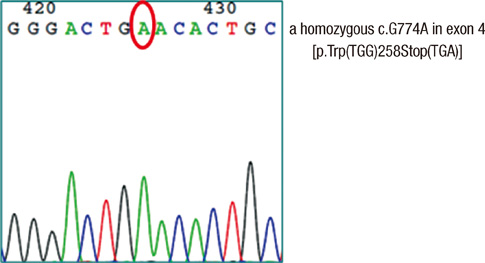J Korean Med Sci.
2011 Sep;26(9):1238-1240. 10.3346/jkms.2011.26.9.1238.
A Case of Exercise-induced Acute Renal Failure with G774A Mutation in SCL22A12 Causing Renal Hypouricemia
- Affiliations
-
- 1Department of Internal Medicine, College of Medicine, Dankook University, Cheonan, Korea. jtcho@dankook.ac.kr
- KMID: 1779401
- DOI: http://doi.org/10.3346/jkms.2011.26.9.1238
Abstract
- Acute renal failure with severe loin pain which develops after anaerobic exercise is rare. One of predisposing factors of exercise-induced acute renal failure is renal hypouricemia. Idiopathic renal hypouricemia is a genetic disorder characterized by hypouricemia with abnormally high renal tubular uric acid excretion. The mutation in SCL22A12 gene which encodes renal uric acid transporter, URAT1, is the known major cause of this disorder. We here described a 25-yr-old man showing idiopathic renal hypouricemia with G774A mutation in SCL22A12 who presented exercise-induced acute renal failure. There have been a few reports of mutational analysis in Korean idiopathic renal hypouricemia without acute renal failure. This is the first report of genetically diagnosed idiopathic renal hypouricemia with exercise-induced acute renal failure in Korea.
Keyword
MeSH Terms
Figure
Cited by 2 articles
-
J-shaped Relationship Between Chronic Kidney Disease and Serum Uric Acid Levels: A Cross-sectional Study on the Korean Population
Bon San Koo, Hye-Jin Jeong, Chang-Nam Son, Sang-Hyon Kim, Gheun-Ho Kim, Jae-Bum Jun
J Rheum Dis. 2021;28(4):225-233. doi: 10.4078/jrd.2021.28.4.225.A Case Report of Familial Renal Hypouricemia Confirmed by Genotyping of
SLC22A12 , and a Literature Review
Hyung Oh Kim, Chun-Gyoo Ihm, Kyung Hwan Jeong, Hyun Joon Kang, Jae-Min Kim, Hyung Suk Lim, Jin Sug Kim, Tae Won Lee
Electrolyte Blood Press. 2015;13(2):52-57. doi: 10.5049/EBP.2015.13.2.52.
Reference
-
1. Ishikawa I. Acute renal failure with severe loin pain and patchy renal ischemia after anaerobic exercise in patients with or without renal hypouricemia. Nephron. 2002. 91:559–570.2. Maesaka JK, Fishbane S. Regulation of renal urate excretion: a critical review. Am J Kidney Dis. 1998. 32:917–933.3. Erley CM, Hirschberg RR, Hoefer W, Schaefer K. Acute renal failure due to uric acid nephropathy in a patient with renal hypouricemia. Klin Wochenschr. 1989. 67:308–312.4. Hisatome I, Ogino K, Kotake H, Ishiko R, Saito M, Hasegawa J, Mashiba H, Nakamoto S. Cause of persistent hypouricemia in outpatients. Nephron. 1989. 51:13–16.5. Igarashi T. Normal serum uric acid concentrations for age and sex and incidence of renal hypouricaemia in Japanese school children. Pediatr Nephrol. 1993. 7:239–240.6. Van Peenen HJ. Causes of hypouricemia. Ann Intern Med. 1973. 78:977–978.7. Tanaka M, Itoh K, Matsushita K, Matsushita K, Wakita N, Adachi M, Nonoguchi H, Kitamura K, Hosoyamada M, Endou H, Tomita K. Two male siblings with hereditary renal hypouricemia and exercise-induced ARF. Am J Kidney Dis. 2003. 42:1287–1292.8. Hosoyamada M, Ichida K, Enomoto A, Hosoya T, Endou H. Function and localization of urate transporter 1 in mouse kidney. J Am Soc Nephrol. 2004. 15:261–268.9. Cheong HI, Kang JH, Lee JH, Ha IS, Kim S, Komoda F, Sekine T, Igarashi T, Choi Y. Mutational analysis of idiopathic renal hypouricemia in Korea. Pediatr Nephrol. 2005. 20:886–890.10. Lee JH, Choi JH, Park YS, Yoo HW, Jeong JY. A case of idiopathic renal hypouricemia with URAT1 gene mutation who showed persistent orange-colored urine. J Korean Soc Pediatr Nephrol. 2006. 10:65–71.11. Han MH, Park SU, Kim DS, Shim JW, Shim JY, Jung HL, Park MS. A case of idiopathic renal hypouricemia. Korean J Pediatr. 2007. 50:489–492.12. Ames BN, Cathcart R, Schwiers E, Hochstein P. Uric acid provides an antioxidant defense in humans against oxidant- and radical-caused aging and cancer: a hypothesis. Proc Natl Acad Sci U S A. 1981. 78:6858–6862.13. Murakami T, Kawakami H, Fukuda M, Furukawa S. Patients with renal hypouricemia are prone to develop acute renal failure: why? Clin Nephrol. 1995. 43:207–208.14. Ishikawa I, Sakurai Y, Masuzaki S, Sugishita N, Shinoda A, Shikura N. Exercise-induced acute renal failure in 3 patients with renal hypouricemia. Nippon Jinzo Gakkai Shi. 1990. 32:923–928.15. Shichiri M, Iwamoto H, Maeda M, Kanayama M, Shiigai T. Hypouricemia due to subtotal defect in the urate transport. Clin Nephrol. 1987. 28:300–303.16. Paller MS, Hoidal JR, Ferris TF. Oxygen free radicals in ischemic acute renal failure in the rat. J Clin Invest. 1984. 74:1156–1164.17. McCord JM. Oxygen-derived free radicals in postischemic tissue injury. N Engl J Med. 1985. 312:159–163.18. Ohta T, Sakano T, Igarashi T, Itami N, Ogawa T. Exercise-induced acute renal failure associated with renal hypouricaemia: results of a questionnaire-based survey in Japan. Nephrol Dial Transplant. 2004. 19:1447–1453.
- Full Text Links
- Actions
-
Cited
- CITED
-
- Close
- Share
- Similar articles
-
- A Case of Recurrent Exercise-Induced Acute Renal Failure and Renal Hypouricemia with R90H Mutation in a SCL22A12 Gene
- Patient with Renal Hypouricemia and Exercise Induced Acute Renal Failure
- Exercise-induced Acute Renal Failure in a Patient with Renal Hypouricemia
- Severe Acute Kidney Injury with Familial Renal Hypouricemia Confirmed by Genotyping of SLC22A12
- A Case of Idiopathic Renal Hypouricemia with URAT1 Gene Mutation who Showed Persistent Orange-colored Urine


